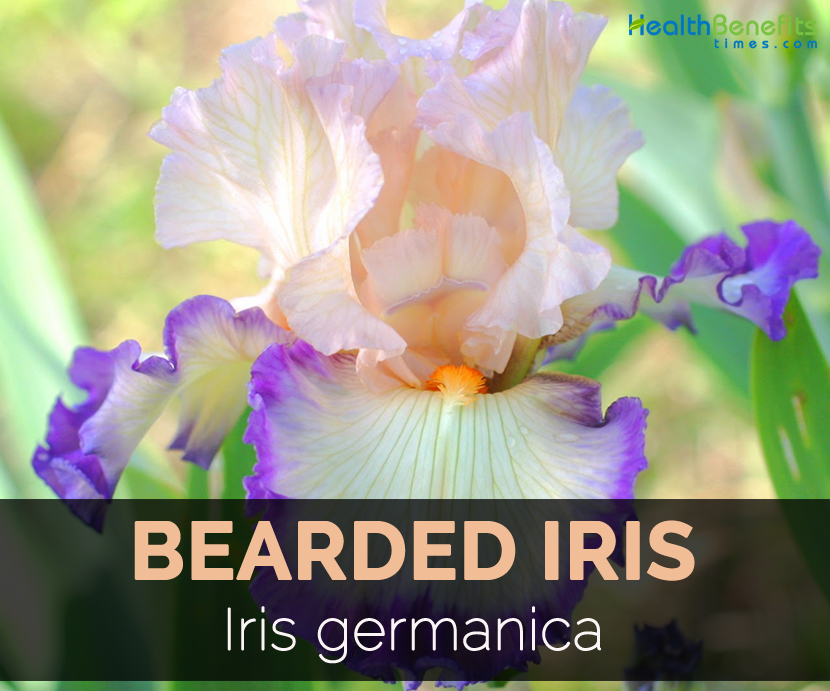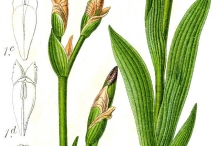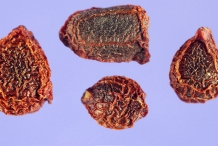Health Benefits of Bearded Iris
The health benefits provided by Bearded Iris is discussed below:
- Treatment for Alzheimer’s disease
An extract of Iris germanica was used for experimenting Alzheimer’s disease. Results showed that it promoted congnitive function of AD rat induced Aβ in the behavioral test. Other studies related to neuropsycopharmacological are essential to figure out the perfect mechanism of action of Bearded Iris as a cure for managing symptoms of Alzheimer’s disease. Moreover, further investigation is still required to identify the main active constituents of Iris germanica that have therapeutic effect on symptoms of Alzheimer’s disease. (1)
Traditional uses
- Juice extracted from juice is used for treating dropsy.
- It is used for treating problems related to lungs, hoarseness, coughs, bronchitis and also chronic diarrhea.
- Chew the pieces of dried root to overcome unpleasant breath.
Precautions
- Leaves and rhizomes contain irisin which is an irritating resinous substance. It could cause severe gastric problems if ingested.
- Some people might get allergies and skin irritations.
- Its excessive use causes vomiting, nausea, colic and purging.
How to Eat
- Peeled rhizomes are used to flavor confectionery, ice cream and baked goods.
- In France, the root starch is regarded as a famine food to extend bread flour after eliminating bitter element.
References:
https://www.itis.gov/servlet/SingleRpt/SingleRpt?search_topic=TSN&search_value=43207#null
https://davesgarden.com/guides/pf/go/189284/
https://www.botanical.com/botanical/mgmh/i/irises08.html
Comments
| Bearded Iris Quick Facts | |
|---|---|
| Name: | Bearded Iris |
| Scientific Name: | Iris germanica |
| Origin | Probably, Iris germanica is originated in Central southern Europe and the Balkan Peninsula. |
| Shapes | Bluntly angled |
| Health benefits | Treatment for Alzheimer's disease |
| Name | Bearded Iris |
|---|---|
| Scientific Name | Iris germanica |
| Native | Probably, Iris germanica is originated in Central southern Europe and the Balkan Peninsula. |
| Common/English Name | Bearded Iris, Flag, Common Orrisroot, Florentine Orris, Garden Iris, Florentine Iris, German Iris, Iris, German Orrisroot, Orris, Orrisroot, Purple Flag, Tall Bearded German Iris, Queen Elizabeth Root, Tall Bearded Iris, Purple Flag, Wild Bearded Iris, Orris-root, Rhizomatous iris, Tall Bearded German Iris, Iris kochii |
| Name in Other Languages | Arabic: Irsa; Chinese: Déguó Yuānwěi; Czech: Kosatec Německý; Danish: Iris, Have-Iris, Sværdlilie; Dutch: Blauwe Lis, Duitse Lis Sort, Duitse Lis, Lis Sort; Esperanto: Irido Germana, Irido Ĝardena; Estonian: Aediiris; Finnish: Saksankurjenmiekka, Sininen Kurjenmiekka; French: Flambe, Iris Allemande, Iris, Iris d’Allemagne, Iris Germanique; German: Deutsche Schwertlilie, Himmelschwertel, Echte Schwertlilie, Gelbe Schwertlilie, Ritter-Schwertlilie, Türk Schwertlilie; Hungarian: Kerti Nőszirom, Nepáli Nőszirom, Kék Nőszirom; India:- Malayalam: Puskaramulam, Manipuri: Kombirei, Sanskrit: Haimavati, Padma-Pushkara, Mulam, Parasikavaca, Puskaramulam; Italian: Giaggiolo Maggiore, Giaggiolo Paonazzo; Japanese: Ayame, Kakitsubata, Hanashoubu; Korean: Ailiseu Germanica; Persian: Bikh-I-Banafshah; Polish: Kosaciec Bródkowy, Kosaciec Niemiecki, Kosaciec Ogrodowy; Portuguese: Lírio-Cardano, Lírio-Da-Alemanha, Lírio-Cardeno, Lírio-Germânico, Lírio-Roxo; Slovašcina: Nemška Perunika, Bradata Perunika, Perunika Nemška; Slovencina: Kosatec Nemecký; Spanish: Lirio Cardeno, Iris, Lirio Común; Swedish: Trädgårdsiris; Thai: M̀āntā Germanica; Tibetan: Su Dag Dkar Po; Turkish: Mor Süsen, Navruzu, Türk Süzeni; Vietnamese: Diên Vỹ German hoa tím; Welsh: Gellesgen Farfog; English: Bearded Iris, Blue Flower De Luce, flag, Fleur-de-lis, Florentine Iris, German iris, iris, orris; Bulgarian: fialki; Hungarian: kék liliom, kék nöszirom, német kardliliom, nöszirom, pompás nöszirom, ékes kardvirág; Italian: fior de San Marco, giglio bianco, giglio di S. Catterina, siaggiolo; Portuguese: Lírio-cardano; Romanian: caciţă, Ceapă, cocoară mnerie, coada cocoşului, cocoş, cocoşei vineţi, cocoşel, crin, cosiţa fetelor, crin vînăt, crin albastru, floare vînătă, găltane vinete, frunză lată, Lilie, iarbă lată, lilie sălbatică, lilion, lilie vînătă, lilion vînăt, lilion albastru, liliu vînăt, pescuţi, paparigă, păpurică, Sabie, sovîrîşcă, sanfii, spetează, stinjeni vineţi, stînjene, stînj, stînjenel de grădină, stînjenei, stînjeni, stînjeni albaştii, stînjin, stînjeniţă, stînjin vînăt, stînjinei, stînjinaşi, stînjinei mnerii, stînjineu, stînjinel de grădină, stînjini mnerii, stînjini, stînjini vineţi, stînjîn, tulipan, stînjînel, şuvar |
| Plant Growth Habit | Rhizomatous, perennial herb |
| Soil | Well-drained, neutral to slightly acidic |
| Plant Size | 120 cm high and 30 cm wide |
| Root | 10 cm deep |
| Leaves | 30-40 cm long, 2.0-4.5 cm broad, dark green, ribbed |
| Flowering Season | Mid-April to Mid-June |
| Flower | Blue-violet, yellow, brown or white |
| Fruit shape & size | Bluntly angled, 3-5 × 2.5 cm |
| Seed | Reddish-brown, wrinkled, oval, 3-4 mm |











